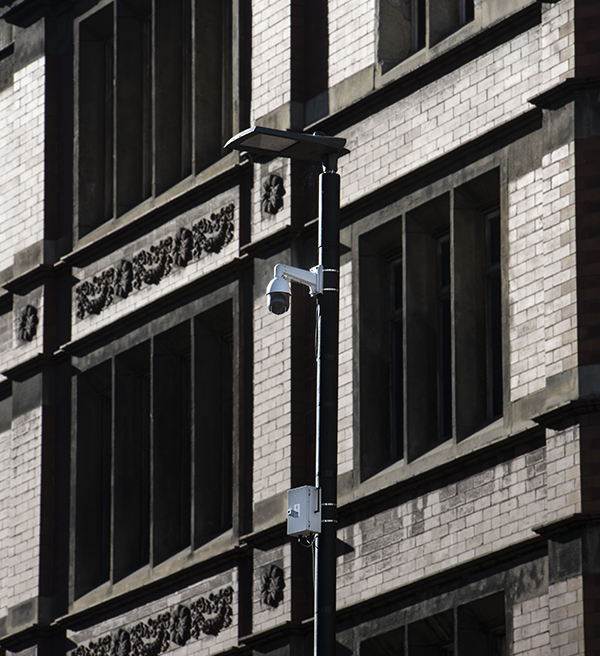Footfall
The R-Com IoT VT footfall counting system uses a lamppost / wall mounted, high resolution video camera to count, record & compare pedestrian activity in a specific location or zone. The primary function of this device is to accurately count footfall entering and leaving a defined zone / specific location within the field of the camera lens.
A dedicated VT processor module captures live video footage of footfall / pedestrian activity and converts this into ‘units / blobs of data’.
Sophisticated, embedded algorithms eliminate potential errors and compensate for shadows, poor light, duplication & tailgating.
Data is transferred to an on board MQTT logger unit where the data is stored and converted to industry standard MQTT format prior to transmission via Wi-Fi / network protocols to a remote Cloud based server.

Converting the data in real time & in situ in this way facilitates significant data compression in order to maximize the efficient storing and subsequent transmission of data for analysis.
All devices are highly secure and can be accessed remotely for remote management, maintenance & calibration.
These devices are usually deployed in two scenarios:
- As a ring of multiple units arranged to monitor the perimeter of a given area / zone in order capture all movement in and out the perimeter. By calibrating the devices around the perimeter duplication can be eliminated enabling the total number of people present & entering / exiting the zone to be recorded on a real time basis. Examples of a zone perimeter could range from the monitoring of every exit / entry into a single shopping street or encompass a wider area such as a pedestrian zone / public area. The primary objective of creating a footfall measurement zone would be to accurately measure the actual volume of people within a given area at a given time.
In addition to the quantitative data (numbers by location / 24hr time stamped), careful positioning and calibration of the units can provide a limited degree of qualitative directional data. This can be used to evaluate the general direction and movement of the overall mass of footfall from street to street rather than accurate tracking of specific individuals.
- As single units designed to monitor and gather base / comparison data for specific hot spots/ events/ areas of special interest. Examples could include: Shopping centres / major public building entry and exit points, public facilities (toilets, Wi-Fi access points, public spaces etc.), bus stops & transport hubs (temporary / fixed), electric charging hubs, stadia/events / public gatherings. The deployment of additional single units can be used very effectively to gather detailed data relating to the use and effectiveness of a specific location. This includes: Number of people by time & date / Average Duration (based on in/out frequency) / Peaks & troughs / Trends & impact analysis.
- Optional features which may require additional equipment ( cameras / VT modules etc.) include Real Time Queue monitoring and Dwell time analysis.
Solution Application and Usage
The real time & time stamped, 24hr base data provided by the R- Com VT Footfall Counter can provide invaluable data regarding the daily life and health of a City economy.
Understanding the quantity, frequency and behavior of pedestrians within very specific locations can give invaluable insights for retailers, planners and businesses within the City.
More traditional ‘clip board ‘surveys and interviews can be better targeted and designed using the highly accurate base data provided.
The solution is particularly effective for collecting baseline historical data to provide accurate business case support before any projects are undertaken.
The data can also be used as before / after impact analysis to demonstrate return on investment following the implementation of City zoning / pedestrian/ infrastructure initiatives.
This can be used very effectively to:
- Monitor the impact of promotions, events & crowd management strategies
- Test re configuration of street layouts & major access / entry points around the given perimeter in order to eliminate congestion / improve flow.
- Detect & record how long people spend/ queue in one place ( Dwell time ) and how often that place was visited, for example: toilets, parks, information boards, public buildings / spaces.
- Test the popularity of new facilities / features through before and after comparison.
- Measure frequency and volume of footfall at different times of day in order to more effectively plan & position related resources
- Manage the flow of human traffic around the busiest routes within town and city centers and high streets.
- Identify security / health & safety black spots.
- Measure usage & popularity of public services locations & transport hubs such as Park & ride / Stations / Bus stops.
- Improve scheduling at busy times of day and peak visitor / commuter periods
- Identify optimal opening / closing times and peak periods.
- Support the case for Business Rates and justify rents through accurate footfall data.
- Control and adhere to maximum capacity limitations in public facilities, outdoor areas and high streets.
Tried and tested in the harshest of weather, our outdoor people counting systems are over 98% accurate even in the busiest situations.